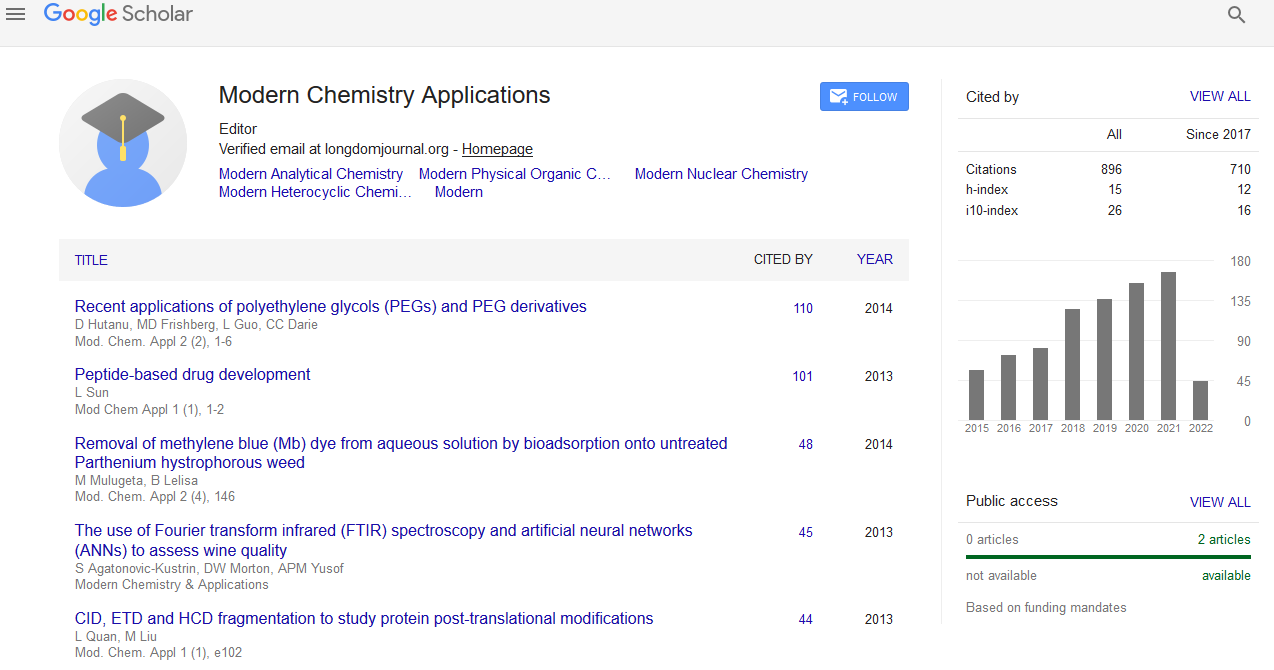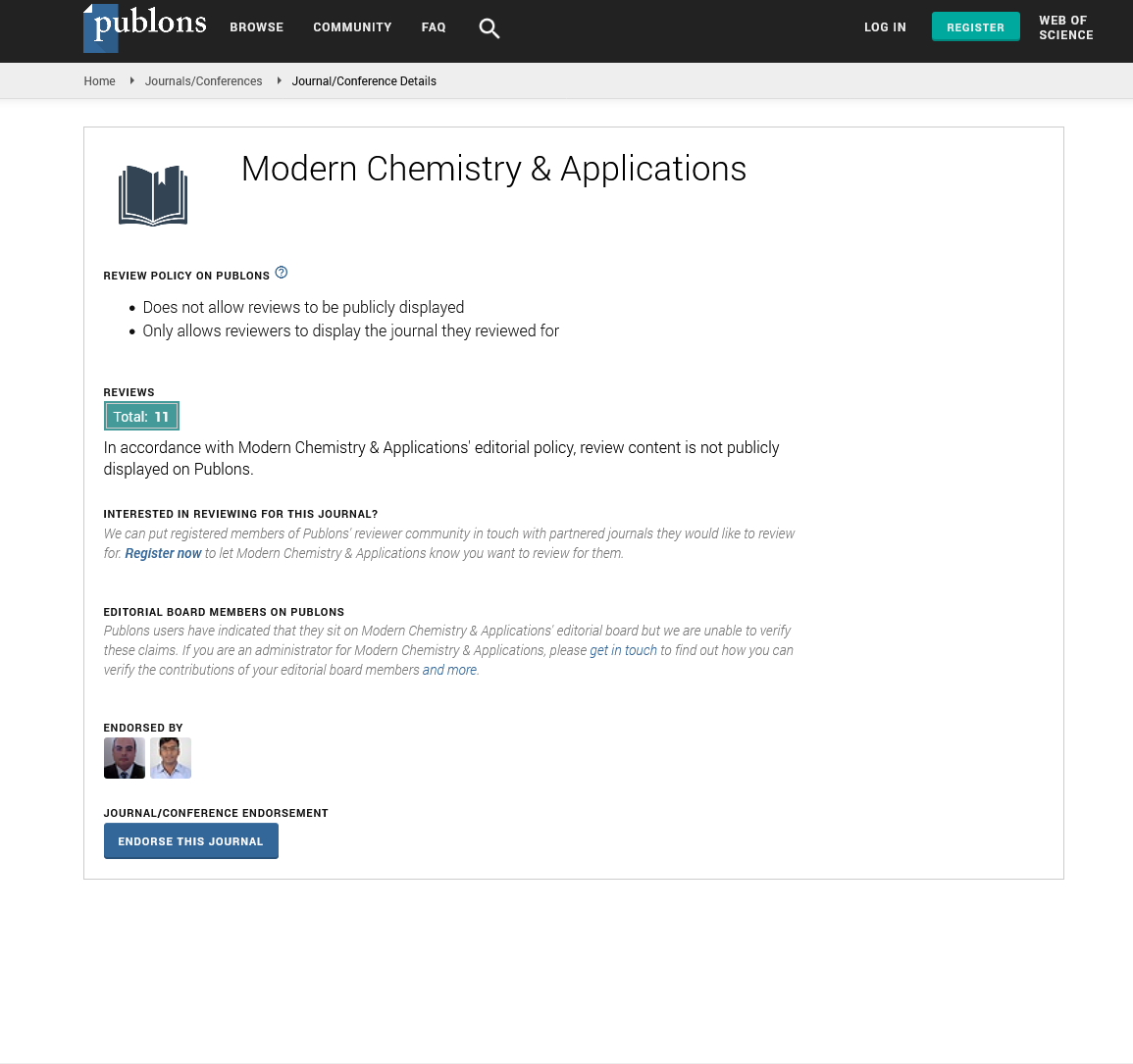Indexed In
- Open J Gate
- JournalTOCs
- RefSeek
- Hamdard University
- EBSCO A-Z
- OCLC- WorldCat
- Scholarsteer
- Publons
- Geneva Foundation for Medical Education and Research
- Google Scholar
Useful Links
Share This Page
Journal Flyer

Open Access Journals
- Agri and Aquaculture
- Biochemistry
- Bioinformatics & Systems Biology
- Business & Management
- Chemistry
- Clinical Sciences
- Engineering
- Food & Nutrition
- General Science
- Genetics & Molecular Biology
- Immunology & Microbiology
- Medical Sciences
- Neuroscience & Psychology
- Nursing & Health Care
- Pharmaceutical Sciences
Opinion Article - (2025) Volume 13, Issue 1
Integrating Quantum Chemistry and Spectroscopy to Explore Molecular Structure and Reactivity
Jonathan Miller*Received: 26-Feb-2025, Manuscript No. MCA-25-29055; Editor assigned: 28-Feb-2025, Pre QC No. MCA-25-29055 (PQ); Reviewed: 14-Mar-2025, QC No. MCA-25-29055; Revised: 21-Mar-2025, Manuscript No. MCA-25-29055 (R); Published: 28-Mar-2025, DOI: 10.35248/2157-7560.25.13.485
Description
Quantum chemistry and spectroscopy have become essential in understanding the structure and behavior of molecules. Together, these disciplines provide a powerful combination of theoretical and experimental tools that allow scientists to study how atoms are arranged in a molecule and how they interact during chemical reactions. By combining mathematical modeling with physical measurements, researchers can interpret complex chemical behavior with greater accuracy.
Quantum chemistry relies on the principles of quantum mechanics to describe how electrons behave in molecules. Unlike classical models that treat atoms as solid spheres, quantum methods consider electrons as wave-like entities, whose distribution around a nucleus determines chemical bonding and molecular stability. Using equations such as the Schrödinger equation, scientists can calculate properties like bond lengths, bond angles, electronic energies and dipole moments. These predictions are based on fundamental physics and they provide insight into why certain molecular structures are more stable or reactive than others.
Spectroscopy, on the other hand, involves the interaction of matter with electromagnetic radiation. Different types of spectroscopy target different aspects of molecular behavior. Infrared spectroscopy, for example, measures how molecular bonds vibrate when exposed to infrared light. Ultraviolet-visible spectroscopy examines electronic transitions, while Nuclear Magnetic Resonance (NMR) spectroscopy looks at how atomic nuclei respond to magnetic fields. Each technique yields specific data that helps to characterize molecular identity, composition and environment.
When used together, quantum chemistry and spectroscopy offer complementary perspectives. Quantum methods can predict spectra before experiments are conducted, helping researchers know what to expect. Conversely, experimental spectra can confirm or refine theoretical models. This feedback loop makes it easier to identify unknown compounds, assign molecular structures and explore reaction mechanisms.
One practical example of this integration is in the study of reaction pathways. By modeling a chemical transformation with quantum methods, researchers can identify intermediate species and transition states, which are often difficult to detect directly. Spectroscopic techniques, such as time-resolved spectroscopy, can then be used to observe these short-lived species in real time. This approach reveals how molecules change shape and energy during a reaction, offering clues about which steps control the reaction rate or influence the product distribution.
Another application is in the field of materials science, where understanding the electronic structure of molecules is vital for designing better conductors, insulators, or semiconductors. Quantum models predict how electrons move through a molecule or solid, while spectroscopic data confirm those behaviors by measuring absorption or emission of light. This combined strategy helps in the design of new compounds for use in solar cells, sensors and electronic devices.
In biological chemistry, the same tools are used to study large and complex systems such as proteins, enzymes and nucleic acids. Quantum methods allow for the modeling of active sites where chemical reactions take place, while spectroscopy provides structural and dynamic information. For example, by combining computational predictions with vibrational spectra, researchers can determine how enzymes change shape when binding to a substrate, or how mutations affect function.
The growing use of computational tools in chemistry has been supported by improvements in hardware and algorithms. Methods such as Density Functional Theory (DFT) balance computational cost and accuracy, allowing researchers to study large molecules or reaction networks. These models are regularly used to simulate spectra, predict reactivity and explore potential energy surfaces. Meanwhile, spectroscopic instruments have become more sensitive and precise, enabling the detection of subtle changes in molecular structure or behavior.
Data obtained from these approaches are often used in education, helping students and early-career researchers visualize abstract concepts like electron density, orbital interactions, or vibrational modes. Interactive models based on quantum calculations can be paired with real spectra to make learning more effective and relevant.
In chemical analysis, the combination of theory and experiment increases confidence in structural identification. For instance, a molecule with a complex spectrum may have multiple candidate structures. Simulated spectra generated from quantum methods can be compared to experimental data, narrowing down the options and leading to more accurate conclusions.
This integrated strategy is also important for developing new chemical processes. By understanding how molecules behave under different conditions, chemists can design more efficient reactions, reduce waste and improve selectivity. Whether in academic research, industrial development, or environmental monitoring, the insights gained from combining quantum chemistry with spectroscopy are widely used and highly valued.
As both fields continue to advance, their integration will likely become even more influential in shaping the future of molecular science. The ability to predict and observe chemical behavior with increasing precision enhances our ability to design materials, control reactions and understand the fundamental nature of chemical interactions.
Citation: Miller J (2025). Integrating Quantum Chemistry and Spectroscopy to Explore Molecular Structure and Reactivity. Modern Chem Appl. 13:485.
Copyright: © 2025 Miller J. This is an open access article distributed under the terms of the Creative Commons Attribution License, which permits unrestricted use, distribution and reproduction in any medium, provided the original author and source are credited.


